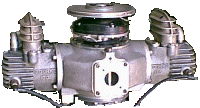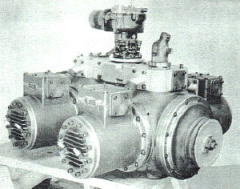|
Quick Survey: How would you like to own your very own Bourke Cycle engine? Available only through Bourke Engine Com! Comes complete with a current computer controlled induction and ignition system, high tech power take off system, truly balanced and vibration free, durable, extremely low emissions, and an instruction manual on how to operate and take care of it as well as a limited 1 year warranty against manufacturer defects? Please sign up below to receive our updates via email! Your informaiton will remain 100% confidential! We are 100% ZERO SPAM!
|
||

Built in 1954. This is Russell's first 30 cubic inch, 30+ HP production engine built for public use. The claims made, except for the unusually high rpm's or the workability of extremely high compression ratios, are true based on real world tests. The key to it's much higher efficiency is simply increased time at Top Dead Center 'TDC'. Back in the 1940's Russell Bourke set out to solve various problems with the conventional engines of that era. During his career as an instructor on internal combustion engines he soon ended up discarding many pre-conceived notions, fixed ideas and incorrectly duplicated theories of how to create the same end result as a steam engine using pressure as the prime mover by converting hydrocarbon based fuels to create pressure against a piston driving it downward in a cylinder and converting it into rotary motion. The first basic and workable theory was in order to create the needed pressure against a piston, combustion of hydrocarbons and air in an enclosed chamber was mandated! In order to accomplish real work it was theorized that 4 separate cycles. 'INTAKE' of air and fuel, 'COMPRESSION' thereof, spark or pressure ignited expansion of those gasses ' POWER' and finally removal of the spent gasses, 'EXHAUST' was necessary. Long ago, Dr. Otto came up with the first practical working engine based on this theory which was a 4 stroke type. It completed 4 cycles in a very literal way in that it had an INTAKE stroke, a COMPRESSION stroke, a POWER stroke and finally and EXHAUST stroke. Do you see the literal translation? The 4 Stroke Cycle was born. The combustion chamber had to be valved in order to enable the cylinder to admit air and fuel and to emit spent gasses and it needed a crankshaft to drive things. There was quite a bit of parasitic power robbing equipment added to accomplish the above complete cycle. Anyway, the first internal combustion piston engine was born and basically it hasn't changed one bit since! Ever since then we have been basically stuck with the Otto cycle to drive anything that requires a 4 stroke/cycle diesel or gasoline engine. The problem isn't so much in Dr. Otto's interpretation of original theory or Dr. Diesel's decision to stick with what works. This includes 2 stroke and turbine engines as well. They are although much simpler and able to yield more power per pound of weight, still prone to similar limitations. Thermodynamically speaking they are flawed relative to their stoichiometric limitations and their complete inability to achieve even a hint of adiabatic efficiency. Although they do work, none of these engine types are capable of adiabatic operation in that their efficiency is gauged based upon fuel rich stoichiometric ratios. Regardless of an engine, be it 2 stroke, 4 stroke or turbine type, they are all inefficient stoichiometric engines in that they emit harmful waste products into the atmosphere! They needlessly pollute our world due to an incomplete combustion process with a great deal of lost heat energy that could and should otherwise be put to work! Regardless of that and to be fair, It remains a fact that conventional engines have worked well for decades and kept the world chugging along faithfully for a long time. But at what cost? We are all seeing the cost now as Russell Bourke predicted decades ago and tried to help prevent! I don't have to tell you what that is as you wouldn't be reading this now if you didn't know or at least suspect that something can be done about it! Yes, the effect is overall environmental degradation due to improperly and incompletely converted hydrocarbons and other toxic substances and gasses! The work engineers and chemists have done, their innovations as well as improvements of conventional engines and hydrocarbon fuels of all types are greatly acknowledged and appreciated. From my perspective, engineers are generally extremely bright intelligent people who solve problems and create! The greater majority of them have a passion for helping their fellow inhabitants live better, take care of and preserve our natural resources. The drive of this website is what Russell Bourke the inventor, Melvin Vaux, John Allen, Roger Richard and a host of others including myself have been talking about and trying to prove for a long time. Something CAN be done about it! As Russell Bourke advocates in his Documentary, there is and has been a better way to squeeze power out of a pound of fuel without wasting it and harming the environment for over 60 years now. Russell Bourke is responsible for this discovery and will always be greatly appreciated and honored for his ingenious and insightful contributions! We at Bourke Engine Com are carrying on his work in his honor and in the name of a better world where people can breath fresh air! Enter Russell Bourke And His Simple Super Efficient Engines!
|

The Bourke 400 Cubic Inch Heavy Duty High Torque / High Horse Power Engine!
Per reports received from Melvin Vaux who knew and worked with Russell, the Bourke 400 was actually designed and built under contract with American Motors Corporation by Russell Bourke and Melvin Vaux. Melvin was Russell's protégé during that time. The 400 was a heavy duty engine designed to be a standard replacement engine built for trucks and tug boats of that era. Per Melvin Vaux, after it had been test run for about 15 minutes or so as per contract, AMC took it away from Russell and never put it to use as they just couldn't get their heads wrapped around it's operation and tried to make it run like a rich 15:1 a/f stoichiometric engine when it was designed and ran fine with ultra lean air fuel ratio's. Per the Documentary the 400 cu. in. engine produced around 200 plus horse power at only 2000 RPM! Since Russell Bourke and Mr. Vaux claimed they were the only ones who really knew how to make it run in super lean mode, AMC's engineers were lost and they gave up on it all together. It has been rumored by Melvin Vaux that the 400 4 cylinder was born out of the 200 cubic inch 2 cylinder Bourke cycle engine that Melvin sized up from the original Bourke 30 before Russell took him on as his understudy. Evidently when Russell saw Melvin's calling card, a light went on and the 400 was born! Melvin incorporated a half shaft crankshaft using a square cupped yoke instead of the 4 piece scotch yoke connecting rod setup as in an original Bourke 30 engine. Not so much an original idea as it was novel on Melvin's part. Melvin's design did accomplish one thing and that was a true 1 piece connecting rod/scotch yoke assembly. Trouble was that in order to keep Melvin's design from bending and breaking at the cup, he had to incorporate a slider plate as a means to keep the setup from breaking. In my opinion this arrangement offers no fundamental improvement over Russell's original design. Same movement, same stroke, same dwell time at TDC and BDC and actually there's no where to mount timing equipment or pumps etc. because there's only one half of a crankshaft sticking out the PTO end. Was Melvin's engine design any better. Evidence of his workmanship and the results thereof say absolutely NOT based on my own personal observations of Melvin's workmanship which is shoddy at best compared to Russell and his obvious jealousy of Russell based on his history working with Russell. Even Melvin's latest creation, the DeVaux 4 cylinder boxer is no more efficient than the original Bourke design. In fact it's less efficient, less powerful and more complex than the original Bourke 30 ever was! The 400 4 cylinder engine was only static estimated @ 200 HP and 500 Ft. Lb. torque at 2000 RPM! It never ran a real test and no one knows the actual power it made based on interviews with Melvin Vaux in 2001. But Melvin Vaux had been running his 2 cylinder 200 cubic inch Bourke twin on natural gas as an irrigation pump for a long time and up until recently in the last 10 years before he retired and turned all his engines over to another company with the hopes that they would finally get something useful done with his version of the original Bourke engines which are in fact a far cry from the original Bourke engine design. Per Melvin Vaux, the Bourke 400 was made due to Russell's abandonment of the 30, the radial 4 cylinder engines and the H 4 cylinder, in an attempt to make enough money to support his wife Lois after he was gone. Russell was very ill and knew he was dying. A sad and pre-mature ending for an incredibly ingenious man who cared deeply about his fellow man and the environmental damage he knew was going to result from the improper design and use of conventional engines and carbon based fuels well ahead of time. Now we see exactly what Russell was talking about all around us! Don't we. At least those who can see that is. Russell lived a very full life as you will find in the Bourke Engine Documentary. Lois was a genuine angel and backed Russell up 100%, up to and after Russell's passing. Russell Bourke was indeed a visionary man. There have been and are still many who carry on his dream and his work. We are part of that group. We are proud of it! The key thing is that the Bourke engine will still run as clean and green as Russell said they will! They do run unusually lean air fuel and high compression ratio's. It's all in the dwell time and the simplicity of the Scotch Yoke mechanism that accomplishes a shorter moment arm and longer torque period with less bore and stroke and moving parts than any conventional engine including Wankles. of equal power that are keys to improved efficiency in any internal combustion engine! |
|
|
Check out our great deals on our products page! Two FREE information packed Ebooks by Russell Bourke with any purchase! |
||
|
Great things happening! If you like, we will keep you up to date via email. How would you like to own one of your very own super efficient Bourke engines? |
||